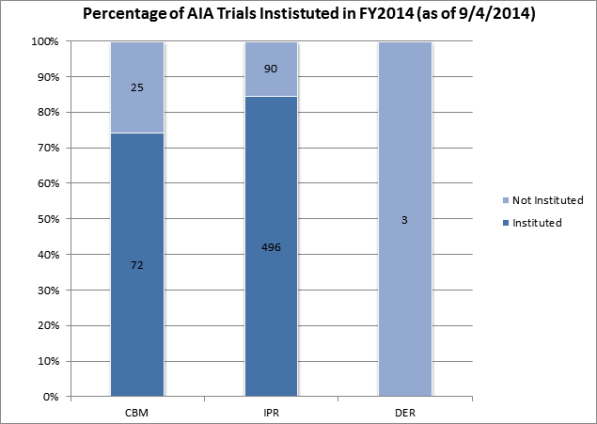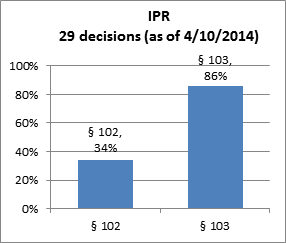As of September 16, 2012, Inter partes review (IPR), Post-Grant review (PGR), and covered business method review (CBM) became options for challenging the validity of issued patents in front of the USPTO's Patent Trial and Appeals Board (PTAB). The popularity of these proceedings is increasing. The following roundup of statistics follows up on our earlier statistical analyses.
The Popularity of AIA Petitions Continues to Increase1
The popularity of AIA petitions has increased every month. Between April 11, 2014 and September 4, 2014, an additional 766 AIA petitions were filed. As of April 10, 2014, a total of 1,196 petitions had been filed. As of September 4, 2014, a total of 1,962 petitions had been filed. Thus far, the total number of petitions has exceeded our earlier projections. Moreover, the number of petitions (766) filed between April 11, 2014 and September 4, 2014 is larger than the total number of petitions filed in FY2013 (563). In the last two months, we also saw the first two petitions for PGRs.

The vast majority of the petitions are for IPR, followed by CBM, followed by derivation proceedings (Derivation), which challenge ownership issues, followed by PGRs. Compared to the statistics in April of this year, the breakdown between the types of AIA trials has remained about the same.

PGRs are only available for patents that are subject to the first-to-file provision of the AIA (which became applicable on March 16, 2013). A PGR must be filed no later than nine months from the issuance of such a patent. As more and more of these patents are issued, the number of PGRs is sure to increase. It is likely that ultimately the number of PGRs will exceed the number of CBMs.
When the number of AIA petitions is compared, there is still a lot of fluctuation from month-to-month. However, the general trend is that the total number of petitions is increasing. Over each of the last five months, more than 100 IPR petitions have been filed.

Most Petitions Are for Electrical/Computer Patents2
Consistent with the trend observed in April, most of the AIA trial petitions are for electrical- or computer-related patents. Compared to the data in April, the percentage of petitions filed for mechanical and bio/pharma patents slightly increased, while the percentage of chemical patents being challenged decreased. Since April 2014, there have been no new petitions filed against design patents.

With the recent filings of PGR petitions, it will be interesting to see if this trend also holds true for PGRs. Thus far, there have only been two PGR petitions, one of which was directed to a mechanical patent and the other to a pharmaceutical patent.
Most Petitions Are Instituted3
Similar to the statistics in April, most IPR and CBM petitions are instituted. However, the percentage of trials instituted has decreased. For IPR petitions, 76% are currently being instituted compared to 80% in April. For CBM petitions, 74% are currently being instituted compared to 84% in April. Thus far, no derivation proceeding has been instituted. As the PGR petitions have only recently been filed, there are no statistics on the institution rates for these proceedings.

The Basis for Unpatentability is Usually Obviousness Under Section 1034
While there are often multiple bases for unpatentability, obviousness under Section 103 has been the most frequent basis for post grant invalidity findings. As of September 4, 2014, in 82% of the CBM decisions, the basis for unpatentability was obviousness under Section 103. The IPR data as of April 2014 is shown for comparison.


The PTAB is Close to Becoming the Most Popular Venue to Challenge Patent Validity
The impact of AIA trials on the way patents are being challenged may be best assessed by comparing the PTAB statistics to patent litigations. The two most active District Courts for new patent cases in 2013 were the District Court for the Eastern District of Texas with 1,511 cases and the District Court for the District of Delaware with 1,336 cases.5 With 1,374 AIA trial petitions thus far in FY20146, the PTAB is close to becoming the most popular venue to challenge patent validity. If this trend continues, by the end of the year the number of cases being filed in front of the PTAB will exceed the number of cases filed in either of these jurisdictions.
The Majority of Petitions Are in Pending Litigation
Of the petitions being filed, a vast majority are in pending litigation. As we previously indicated, it is estimated that between 80-90% of all AIA trial petitions are filed against patents that are involved in District Court litigation.7 Moreover, for AIA trial petitions against patents involved in litigation, the success rate of a stay is about 60%.8
What do these numbers mean?
The statistics indicate that AIA trials are here to stay. With the increasing popularity of these proceedings, it seems that the PTAB is becoming the preferred forum in which to litigate the validity of patent claims. The reasons for this include: more technologically proficient judges; lower burdens for challengers; a perceived benefit to challengers; the likelihood of a quicker resolution of the validity challenge; and the likelihood of a cheaper challenge when compared to District Court litigation.
[1] The actual data is from the PTO. The 2014 projection is based on an assumption that the rate from the beginning of 2014 continues through the fiscal year [Calculation: (data as of 9/4/14) / (247 days elapsed) * (365 days per year)].
[2] http://www.uspto.gov/ip/boards/bpai/stats/aia_statistics_09_04_2014.pdf
[3] http://www.uspto.gov/ip/boards/bpai/stats/090414_aia_stat_graph.pdf
[4] Data obtained from http://www.patentboardferret.com/decisions and Patent Trial and Appeal Board Statistics (published April 23, 2014)
[5] Docket Navigator Patent Litigation Statistics, available online at https://www.docketnavigator.com/stats/ (last accessed 9/10/2014)
[6] http://www.uspto.gov/ip/boards/bpai/stats/aia_statistics_09_04_2014.pdf
[7] See Patent Trial and Appeal Board Statistics (published April 23, 2014)
[8] Docket Navigator Success Rates for Motions to Stay Pending Reexamination available online